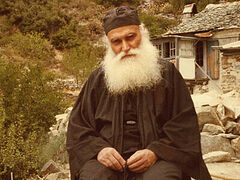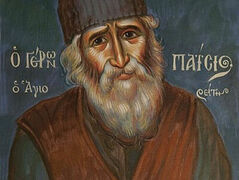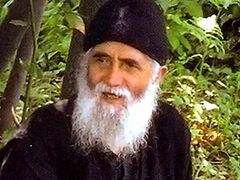This article was originally published in Russian in January 2015, just a few days after St. Paisios the Athonite was canonized.
 Grave of Elder Paisios at the Hesychaterion of St. John the Theologian in Souroti. Photo: A. Pospelov/Pravoslavie.ru
Grave of Elder Paisios at the Hesychaterion of St. John the Theologian in Souroti. Photo: A. Pospelov/Pravoslavie.ru
On January 13, 2015, the Holy Synod of the Patriarchate of Constantinople made the historical decision to canonize Elder Paisios the Athonite. For many Orthodox, he was a saint already during his lifetime. There are many miracles associated with him. I would like to tell you about one of them.
I heard this story from a Greek chauffeur (I think his name was Ioannis). He told me this story in 1997 in Thessaloniki, when I had the chance to accompany Archimandrite Pankraty (now a bishop) as his translator.
Ioannis told me the following:
I heard a lot about Fr. Paisios during his lifetime, about his instructions and miracles, but for some reason I never made him to see him at the monastery in Souroti. Something always came up and there was always a reason to postpone the trip. Then soon after the Elder’s repose, I fell ill with sciatica and got very sick. I even had to leave my job for a while. It was clear what this meant for my family—impending poverty.
Then one day I had a dream. I saw Elder Paisios coming towards my bed (I knew his face from photographs), and he took me by the hand and carried me somewhere. He took me to a rather high mountain, where there was a beautiful Byzantine church on top. He carried me into the church and carefully placed me on the ambo. That’s when I woke up.
 Hesychasterion of St. John the Theologian and St. Arsenios the Cappadocian in Souroti. Photo: A. Pospelov/Pravoslavie.ru
Hesychasterion of St. John the Theologian and St. Arsenios the Cappadocian in Souroti. Photo: A. Pospelov/Pravoslavie.ru
When I woke up, I asked my friend, who had told me a lot about Elder Paisios, to take me to Souroti. I got there with great difficulty, barely able to contain my groans. When we arrived at the monastery, I was shocked. Before me towered a mountain, and on it was a magnificent church—exactly like the one I had seen in my dream. I reached the monastery with great difficulty, I entered the church to pray, and then—to the grave of the Elder. And when, with great difficulty, I prostrated before the cross under which lies his precious body, a miracle occurred. The pain left me and I became completely healthy, just like before. And by the prayers of Elder Paisios, I’m still working today.
I remembered this story when I heard the joyous news of the glorification of Elder Paisios as a saint. And that’s not the only miracle of Elder Paisios I know about, but more about that later.
 Christ the Pantocrator, St. John the Theologian, and St. Arsenios of Cappadocia. Mosaic at the entrance to the monastery in Souroti. Photo: A. Pospelov/Pravoslavie.ru
Christ the Pantocrator, St. John the Theologian, and St. Arsenios of Cappadocia. Mosaic at the entrance to the monastery in Souroti. Photo: A. Pospelov/Pravoslavie.ru
And also, the decision of the Holy Synod of the Patriarchate of Constantinople is a good example for us that there’s no need to wait fifty or more years to glorify an ascetic of piety if his life and miracles are obvious. Other examples of this include the glorification of Sts. Basil the Great, Ambrose of Milan, and Gregory Palamas. And it’s gratifying that Elder Paisios was numbered among the saints when there are still people living who saw his holy life and miracles, who heard his instructions, meaning his holiness can be confirmed not by books and documents, but by eyewitnesses. Unfortunately, I didn’t know the great Elder, but the Lord vouchsafed me to speak with some of those who knew him, including some of the older brothers of the Sinai Monastery, who testified to his self-sacrificial asceticism, that he severely limited himself in food and water despite his severe lung disease, while showing great patience in the obediences entrusted to him, and gentleness and warmth. And thank God that now we can prayerfully cry out: “Venerable Father Paisios, pray to God for us!”



